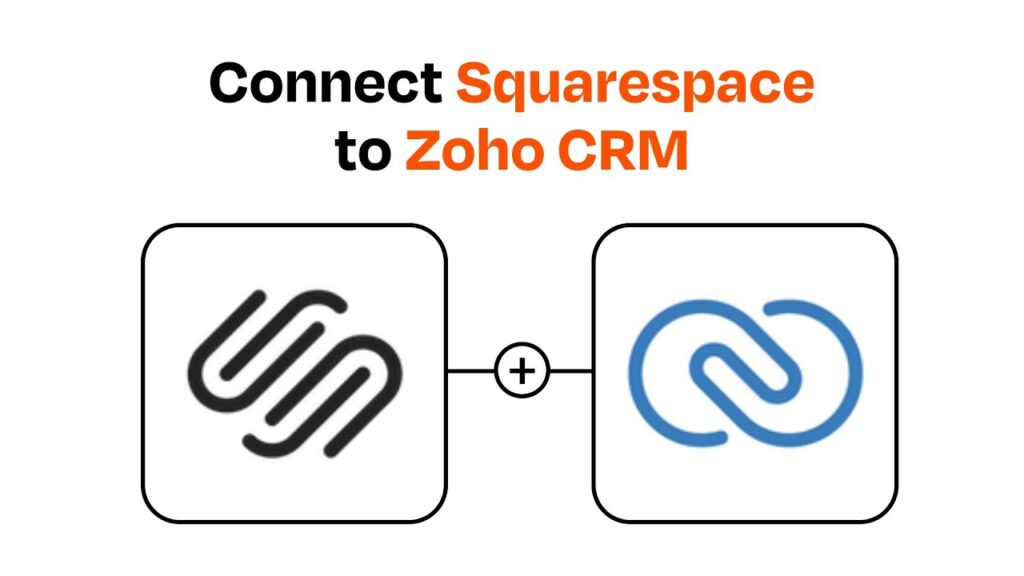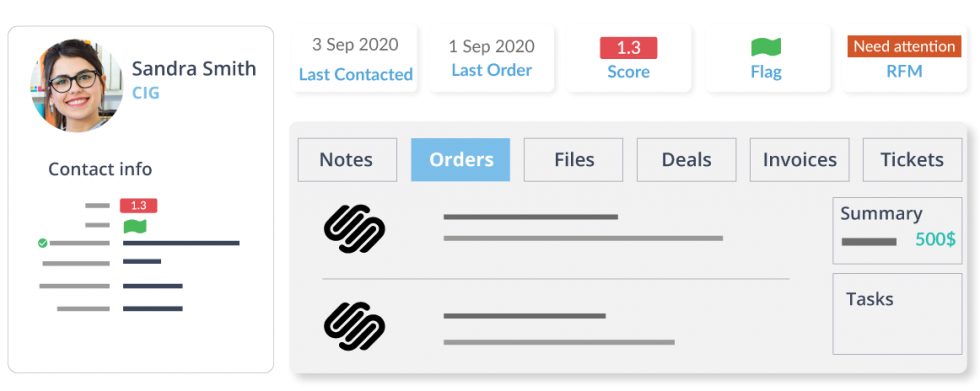
Unlocking the Power of CRM Integration with Squarespace
So, you’ve poured your heart and soul into building a beautiful Squarespace website. It’s visually stunning, user-friendly, and showcases your brand perfectly. But is it truly *working* for you? Are you capturing leads, nurturing relationships, and driving conversions? If you’re nodding your head, then you’re likely already aware of the vital role a Customer Relationship Management (CRM) system plays in business success. And if you’re not, well, buckle up, because integrating a CRM with your Squarespace site is about to revolutionize the way you do business.
This comprehensive guide will walk you through everything you need to know about CRM integration with Squarespace. We’ll explore the ‘why,’ the ‘how,’ and the ‘what’ – from understanding the benefits to selecting the right CRM for your needs and, of course, the step-by-step instructions to get everything set up. Get ready to transform your Squarespace site from a pretty face into a powerful lead-generating, customer-nurturing machine.
Why Integrate a CRM with Squarespace? The Benefits are Crystal Clear
Let’s be honest, running a business is hard work. You’re juggling a million things at once – marketing, sales, customer service, and the list goes on. A CRM system acts like your central command center, organizing all your customer data and interactions in one place. But why specifically integrate it with Squarespace? Here’s why:
- Centralized Customer Data: Imagine having all your customer information – contact details, purchase history, communication logs, and more – readily available in one place. No more scattered spreadsheets or lost emails. A CRM integration brings all this data together, providing a 360-degree view of your customers.
- Improved Lead Generation and Qualification: Squarespace forms, combined with a CRM, are a lead generation powerhouse. Capture leads directly from your website, automatically segment them based on their behavior, and nurture them with targeted email campaigns.
- Enhanced Sales Efficiency: Sales teams can work smarter, not harder. With CRM integration, they can track leads, manage opportunities, and close deals more effectively. Automation features streamline repetitive tasks, freeing up time for building relationships and closing sales.
- Personalized Customer Experiences: Understanding your customers allows you to personalize their experience. With CRM data, you can tailor your website content, email marketing, and customer service interactions to meet their specific needs and preferences.
- Increased Customer Retention: Happy customers are loyal customers. CRM integration helps you track customer interactions, address issues promptly, and provide exceptional customer service, leading to higher retention rates.
- Data-Driven Decision Making: CRM systems provide valuable insights into your customer behavior, sales performance, and marketing effectiveness. This data empowers you to make informed decisions, optimize your strategies, and drive growth.
- Automation of Repetitive Tasks: Time is money, and CRM integration helps you save both. Automate tasks like lead assignment, email follow-ups, and data entry, freeing up your team to focus on more strategic initiatives.
In short, integrating a CRM with Squarespace is like giving your business a superpower. It allows you to work smarter, improve customer relationships, and ultimately, drive more revenue.
Choosing the Right CRM for Your Squarespace Site: A Match Made in Business Heaven
The CRM landscape is vast, with a multitude of options available. Choosing the right one for your Squarespace site depends on your specific needs, budget, and technical expertise. Here’s a breakdown of some of the most popular and effective CRM systems that integrate well with Squarespace:
1. HubSpot CRM
HubSpot is a leading CRM platform, renowned for its user-friendliness and comprehensive features. It offers a free CRM version, making it an excellent starting point for small businesses. Key features for Squarespace integration include:
- Contact Management: Automatically sync contacts from your Squarespace forms.
- Email Marketing: Send targeted email campaigns and track their performance.
- Sales Automation: Automate sales processes and track deals.
- Reporting and Analytics: Gain insights into your sales and marketing efforts.
- Free Version: A generous free plan allows you to get started without any upfront costs.
Who it’s best for: Small to medium-sized businesses looking for a user-friendly, all-in-one CRM solution with a strong focus on marketing and sales.
2. Pipedrive
Pipedrive is a sales-focused CRM designed to help you manage your sales pipeline and close deals. It’s known for its visual pipeline interface and ease of use. Key features for Squarespace integration include:
- Lead Management: Track leads and manage their progress through the sales pipeline.
- Deal Tracking: Visualize your sales deals and track their stages.
- Automation: Automate repetitive sales tasks, such as follow-up emails.
- Reporting: Generate sales reports and track your performance.
- Integration with other tools: Connects with various other tools you may already use.
Who it’s best for: Sales teams and businesses that prioritize a visual sales pipeline and deal tracking.
3. Zoho CRM
Zoho CRM is a robust and feature-rich CRM platform suitable for businesses of all sizes. It offers a wide range of features and customization options. Key features for Squarespace integration include:
- Contact Management: Manage contacts and track their interactions.
- Sales Automation: Automate sales processes and workflows.
- Marketing Automation: Run email marketing campaigns and nurture leads.
- Customization: Customize the CRM to fit your specific business needs.
- Scalability: Offers plans to accommodate businesses of all sizes.
Who it’s best for: Businesses looking for a feature-rich, customizable CRM platform that can scale with their growth.
4. ActiveCampaign
ActiveCampaign is a customer experience automation platform that combines CRM, email marketing, and marketing automation. It’s ideal for businesses that want to nurture leads and create personalized customer journeys. Key features for Squarespace integration include:
- Marketing Automation: Create automated email sequences and workflows.
- Contact Management: Manage contacts and segment them based on their behavior.
- Email Marketing: Send targeted email campaigns.
- CRM: Track deals and manage sales pipelines.
- Advanced Segmentation: Segment your audience based on intricate criteria.
Who it’s best for: Businesses that want to automate their marketing and sales processes and create personalized customer experiences.
5. Other CRM Options
While HubSpot, Pipedrive, Zoho CRM, and ActiveCampaign are popular choices, other CRM platforms may also integrate with Squarespace, depending on your specific needs. These include:
- Salesforce: A powerful enterprise-level CRM.
- Insightly: A CRM for small businesses.
- Freshsales: An AI-powered CRM for sales teams.
Important Note: The level of integration and the specific features available will vary depending on the CRM platform and the integration method you choose. Always check the documentation of both Squarespace and your chosen CRM to ensure compatibility and understand the available features.
How to Integrate a CRM with Squarespace: Step-by-Step Instructions
The process of integrating a CRM with Squarespace can vary depending on the specific CRM platform you choose. However, the general steps are similar. Here’s a breakdown of the typical integration process:
1. Choose Your CRM and Sign Up
Select the CRM that best fits your needs and budget (as discussed above). Sign up for an account and familiarize yourself with the platform.
2. Understand the Integration Methods
There are generally two main methods for integrating a CRM with Squarespace:
- Native Integrations: Some CRM platforms offer native integrations with Squarespace. This means they have built-in connections that allow you to easily connect your accounts. These integrations are typically the easiest to set up.
- Third-Party Integrations (Zapier, etc.): If your chosen CRM doesn’t have a native integration, you can often use a third-party integration platform like Zapier, Make (formerly Integromat), or Automate.io. These platforms act as a bridge between your CRM and Squarespace, allowing you to automate tasks and sync data.
3. Native Integration Setup (If Available)
If your CRM offers a native integration:
- Log in to your CRM account.
- Navigate to the integrations section. (This is usually found in the settings or administration area.)
- Find the Squarespace integration.
- Follow the on-screen instructions to connect your Squarespace account. This typically involves authorizing the connection and providing your Squarespace website URL.
- Configure the integration settings. This might include specifying which data to sync (e.g., form submissions, customer information) and how often the data should be synced.
- Test the integration to ensure it’s working correctly. Submit a test form on your Squarespace website and verify that the data appears in your CRM.
4. Third-Party Integration Setup (Zapier Example)
If you’re using a third-party integration platform like Zapier:
- Create a Zapier account (or use a similar platform).
- Connect your Squarespace account. You’ll need to authorize Zapier to access your Squarespace data.
- Connect your CRM account. Similarly, authorize Zapier to access your CRM data.
- Create a Zap. A Zap is an automated workflow that connects two or more apps.
- Choose a trigger. The trigger is the event that starts the Zap. For example, the trigger could be a new form submission on your Squarespace website.
- Choose an action. The action is the task that the Zap performs. For example, the action could be to create a new contact in your CRM.
- Map the fields. Tell Zapier which data from your Squarespace form should be sent to which fields in your CRM.
- Test the Zap. Test your Zap to ensure it’s working correctly. Submit a test form and verify that the data is correctly transferred to your CRM.
- Turn on the Zap. Once you’re satisfied that the Zap is working, turn it on to automate the process.
5. Configure Squarespace Forms
Regardless of the integration method, you’ll need to ensure your Squarespace forms are set up to capture the necessary information. This typically involves:
- Creating forms: Use the Squarespace form builder to create forms that collect the information you need from your visitors (e.g., name, email address, phone number).
- Adding form fields: Include relevant fields to capture the data you want to sync with your CRM.
- Customizing forms: Customize your forms to match your brand and website design.
6. Testing and Troubleshooting
After setting up the integration, it’s crucial to thoroughly test it. Here’s what you should do:
- Submit test forms: Fill out your Squarespace forms with test data and submit them.
- Check your CRM: Verify that the test data has been correctly synced to your CRM.
- Review data fields: Ensure that the data fields are mapped correctly and that the information is being displayed as expected.
- Troubleshoot any issues: If you encounter any problems, consult the documentation for your CRM and integration platform. Check for common issues, such as incorrect field mapping or authentication errors.
7. Ongoing Maintenance
Once the integration is set up, it’s essential to maintain it. This includes:
- Monitoring data flow: Regularly check that the data is being synced correctly.
- Updating forms: If you change your Squarespace forms, make sure to update the integration settings to reflect the changes.
- Reviewing CRM settings: Review your CRM settings periodically to ensure they still meet your needs.
- Staying updated: Keep up-to-date with the latest features and updates for your CRM and integration platform.
Advanced CRM Integration Strategies for Squarespace
Once you have a basic CRM integration in place, you can take it to the next level with these advanced strategies:
1. Segmentation and Personalization
Use your CRM data to segment your audience and personalize their experiences. This includes:
- Segmenting leads: Divide your leads into different segments based on their behavior, demographics, and interests.
- Personalizing email marketing: Send targeted email campaigns to specific segments of your audience.
- Customizing website content: Display different content to different segments of your audience based on their CRM data.
2. Lead Scoring and Nurturing
Implement lead scoring to prioritize your leads and focus on the most promising ones. Then, create automated nurturing sequences to guide leads through the sales funnel. This includes:
- Setting up lead scoring rules: Assign points to leads based on their interactions with your website, emails, and other marketing materials.
- Creating nurturing workflows: Send automated email sequences to nurture leads and move them closer to a purchase.
- Tracking lead progress: Monitor the progress of your leads through the sales funnel and identify areas for improvement.
3. E-commerce Integration
If you have an e-commerce store on Squarespace, integrate your CRM with your e-commerce platform to track customer purchases, abandoned carts, and other valuable data. This enables you to:
- Track customer purchases: See what products your customers are buying.
- Recover abandoned carts: Send automated emails to customers who have abandoned their carts.
- Offer personalized product recommendations: Recommend products based on their purchase history.
4. Customer Service Integration
Integrate your CRM with your customer service platform to provide better customer support. This includes:
- Tracking customer support tickets: See all customer support interactions in one place.
- Providing personalized support: Use CRM data to personalize your customer service interactions.
- Improving customer satisfaction: Provide faster and more effective customer support.
5. Website Behavior Tracking
Track your website visitors’ behavior to understand their interests and personalize their experience. This includes:
- Tracking page views: See which pages your visitors are viewing.
- Tracking clicks: See which links your visitors are clicking.
- Creating custom events: Track specific actions, such as video views or form submissions.
Troubleshooting Common CRM Integration Issues
Even with the best planning, you may encounter some hiccups during the CRM integration process. Here are some common issues and how to resolve them:
- Data Syncing Issues:
- Problem: Data isn’t syncing between Squarespace and your CRM.
- Solution: Double-check your integration settings, ensure the correct fields are mapped, and verify that the data is being sent to the correct destination. Test the integration again with a new form submission. Check your CRM’s logs for any errors.
- Field Mapping Errors:
- Problem: Data is appearing in the wrong fields in your CRM.
- Solution: Carefully review your field mappings in the integration settings. Ensure that each field in your Squarespace form is correctly mapped to the corresponding field in your CRM.
- Authentication Problems:
- Problem: You’re unable to connect your Squarespace and CRM accounts.
- Solution: Verify your login credentials for both accounts. Ensure that you have the necessary permissions to access the data. Try disconnecting and reconnecting your accounts. Check the documentation for your CRM and integration platform for any specific authentication requirements.
- Form Submission Errors:
- Problem: Form submissions are failing to send data to your CRM.
- Solution: Check your Squarespace form settings to ensure that the form is properly configured. Verify that the form is active and that the submission action is set correctly. Test the form submission to see if you receive any error messages. Check your CRM’s logs for any errors related to form submissions.
- Data Formatting Issues:
- Problem: Data is being formatted incorrectly in your CRM.
- Solution: Check the data formatting options in your integration settings. Make sure that the data types (e.g., text, numbers, dates) are compatible between Squarespace and your CRM. If necessary, use formatting functions in your integration platform to convert the data to the correct format.
- Slow Sync Times:
- Problem: It’s taking a long time for data to sync between Squarespace and your CRM.
- Solution: Check the sync frequency settings in your integration platform. Consider increasing the sync frequency if necessary. Optimize your forms and CRM settings to improve performance. If the problem persists, contact the support team for your CRM or integration platform.
- Contact Duplication:
- Problem: Duplicate contacts are being created in your CRM.
- Solution: Implement deduplication rules in your CRM to automatically merge duplicate contacts. Review your integration settings to ensure that the integration is not creating duplicate contacts.
By carefully addressing these potential issues, you can ensure a smooth and successful CRM integration.
The Future of CRM and Squarespace Integration
The integration of CRM systems with website platforms like Squarespace is constantly evolving. As technology advances, we can expect to see even more sophisticated and seamless integrations in the future. Here are some trends to watch:
- AI-Powered Integrations: Artificial intelligence is already playing a role in CRM, and we can expect to see it further integrated with website platforms. AI can automate tasks, personalize customer experiences, and provide valuable insights into customer behavior.
- Enhanced Personalization: CRM integrations will become even better at enabling personalized experiences. This will include dynamic content, personalized product recommendations, and tailored email marketing campaigns.
- Improved Automation: Automation will continue to expand, streamlining more business processes and freeing up time for more strategic initiatives.
- Seamless E-commerce Integrations: E-commerce integration will become more robust, allowing businesses to track customer purchases, manage abandoned carts, and provide personalized product recommendations more effectively.
- Focus on Customer Experience: The focus will shift even more towards creating exceptional customer experiences. CRM integrations will play a key role in helping businesses understand their customers and provide the best possible service.
Staying ahead of these trends will be crucial for businesses looking to leverage the full potential of CRM integration with Squarespace.
Conclusion: Embrace the Power of CRM Integration
Integrating a CRM with your Squarespace website is a game-changer. It’s an investment that can significantly improve your lead generation, sales efficiency, customer relationships, and overall business success. By following the steps outlined in this guide and choosing the right CRM for your needs, you can transform your Squarespace site into a powerful engine for growth.
Don’t just settle for a pretty website. Embrace the power of CRM integration and unlock the full potential of your online presence. Your customers, and your bottom line, will thank you for it.


